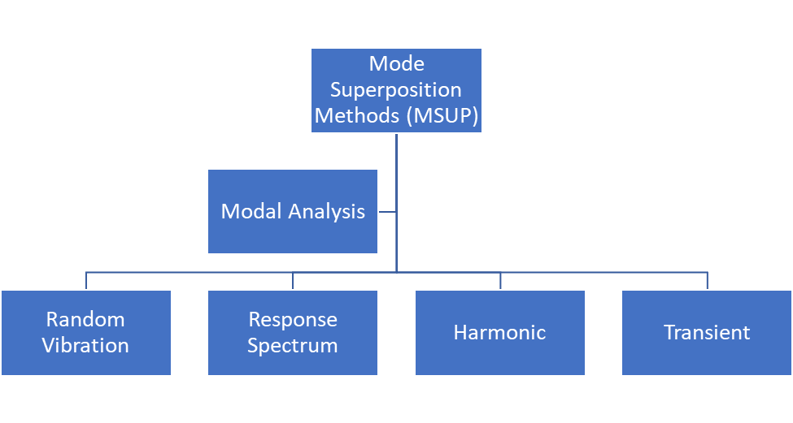Mode Superposition Methods in Linear Dynamics
The mode-superposition method is a valuable tool in linear dynamics for efficiently determining the system response in either the frequency domain or the time domain. It is necessary to use this method for certain types of linear dynamic analyses, so understanding the procedure is crucial for obtaining accurate results. In this blog, we will explain briefly various types of linear dynamic analysis and offer valuable insights to help users better understand and apply these methods to their engineering problems. So, Let's dive right in and get started!
Understanding Modal Analysis
Figure 1: An Example for Natural Frequency Result
Modal analysis serves as the cornerstone of the mode superposition method, providing key insights into how structures vibrate. This technique helps extract crucial information about the design:
- Natural frequencies
- Mode shapes
- Mode participation factors
- Pre-stress effects
Engineers can gain a deeper understanding of how structures behave under different dynamic loading conditions with result of modal analysis.
What is Mode Superposition Method?
The Mode Superposition Method (MSUP) is a fast and effective way to solve dynamic problems. It involves combining multiple modes in a linear manner. Mode-superposition is a powerful technique that uses the natural frequencies and mode shapes obtained from modal analysis to effectively capture the dynamic behavior of a structure under various types of excitations.
A modal analysis needs to be solved to use the mode superposition method for dynamics problems including:
- Harmonic
- Random vibration
- Response spectrum
- Transient dynamics

Random Vibration Analysis
The Random Vibration Analysis is used to determine how components respond to random vibrations. Output is probability distribution of response under power spectrum representing probability distribution of excitation. Examples include:
- Bridges subjected to wind-induced vibrations
- Parts on a manufacturing line or inside vehicles
- Vehicles travelling on a roadway
- Spacecraft during launch
Response Spectrum Analysis
The Response Spectrum analysis is mainly used in place of a time-history analysis to determine the response of structures to random or time-dependent loading conditions under spectrum representing the response. Examples include:
- Buildings experiencing seismic activity during earthquakes.
- Bridges facing strong winds during storms.
- Offshore platforms encountering ocean wave loads during harsh weather conditions.
- Rocket motor vibrations.
- Shock Testing.
Harmonic Analysis
The Harmonic Analysis is used to determine a structure’s response to steady, harmonic loads (sinusoidally varying) providing key insights into how structures respond. Examples include:
- Mechanical systems subjected to rotating unbalanced forces
- High-rise buildings affected by wind-induced harmonic loads
- Sine sweep
- Frequency sweep
Transient Analysis
A transient analysis can be used to calculate a structure’s response to time-varying loads.
- Structural response to sudden impact or collision
- Drop test
- Rail impact
- Shock testing
Free Resources and Materials for Learning Linear Dynamics
By leveraging the Mode Superposition Method and its associated analyses, engineers can more accurately and rapidly predict and address the dynamic behavior and fatigue life of their designs, thereby ensuring their safety and durability in various real-world scenarios. To delve deeper into this topic and access additional informative resources, you can explore the following links:
Foundations in Linear Dynamics Learning Track | Ansys Courses
Linear Dynamics Using Ansys Mechanical Learning Track | Ansys Courses
Tags:
Mechanical, Ansys, Modal Analysis, Transient Analysis, Modal-based Methods, Harmonic Response, Random Vibration, Response Spectrum, seismic, PSD, ASD, Sine SweepNov 7, 2023 12:50:35 PM
